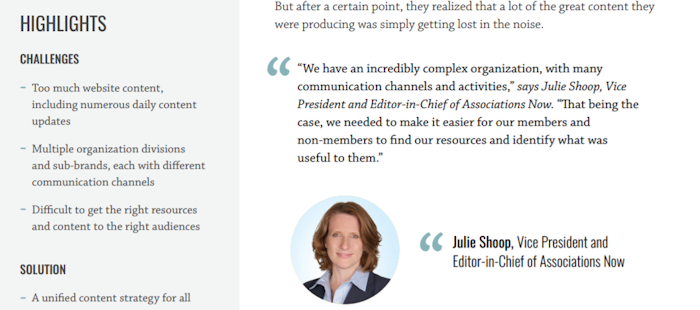If you want to learn how to write a case study that engages prospective clients, demonstrates you can solve real business problems, and showcases the results you deliver, this guide will help.
We’ll give you a proven template to follow, show you how to conduct an engaging interview, and give you several examples and tips for best practices.
Let’s start with the basics.
What is a Case Study?
A business case study is simply a story about how you successfully delivered a solution to your client.
Case studies start with background information about the customer, describe problems they were facing, present the solutions you developed, and explain how those solutions positively impacted the customer’s business.
Do Marketing Case Studies Really Work?
Absolutely. A well-written case study puts prospective clients into the shoes of your paying clients, encouraging them to engage with you. Plus, they:
- Get shared “behind the lines” with decision makers you may not know;
- Leverage the power of “social proof” to encourage prospective clients to take a chance with your company;
- Build trust and foster likeability;
- Lessen the perceived risk of doing business with you and offer proof that your business can deliver results;
- Help prospects become aware of unrecognized problems;
- Show prospects experiencing similar problems that possible solutions are available (and you can provide said solutions);
- Make it easier for your target audience to find you when using Google and other search engines.
Case studies serve your clients too. For example, they can generate positive publicity and highlight the accomplishments of line staff to the management team. Your company might even throw in a new product/service discount, or a gift as an added bonus.
But don’t just take my word for it. Let’s look at a few statistics and success stories:
2018 Content Preferences Survey Report
5 Winning Case Study Examples to Model
Before we get into the nuts and bolts of how to write a case study, let’s go over a few examples of what an excellent one looks like.
The five case studies listed below are well-written, well-designed, and incorporate a time-tested structure.
1. Lane Terralever and Pinnacle at Promontory

This case study from Lane Terralever incorporates images to support the content and effectively uses subheadings to make the piece scannable.
2. WalkMe Mobile and Hulyo

This case study from WalkMe Mobile leads with an engaging headline and the three most important results the client was able to generate.
In the first paragraph, the writer expands the list of accomplishments encouraging readers to learn more.
3. CurationSuite Listening Engine

This is an example of a well-designed printable case study. The client, key problem, and solution are called out in the left column and summarized succinctly.
4. Brain Traffic and ASAE

This long format case study (6 pages) from Brain Traffic summarizes the challenges, solutions, and results prominently in the left column. It uses testimonials and headshots of the case study participants very effectively.
5. Adobe and Home Depot

This case study from Adobe and Home Depot is a great example of combining video, attention-getting graphics, and long form writing. It also uses testimonials and headshots well.
Now that we’ve gone over the basics and showed a few great case study examples you can use as inspiration, let’s roll up our sleeves and get to work.
A Case Study Structure That Pros Use
Let’s break down the structure of a compelling case study:
Choose Your Case Study Format
In this guide, we focus on written case studies. They’re affordable to create, and they have a proven track record. However, written case studies are just one of four case study formats to consider:
- Written
- Video
- Podcast
- Infographic
If you have the resources, video (like the Adobe and Home Depot example above) and podcast case studies can be very compelling. Hearing a client discuss in his or her own words how your company helped is an effective content marketing tool.
Infographic case studies are usually one-page images that summarize the challenge, solution, and results. They tend to work well on social media.
Follow a Tried-and-True Case Study Template
The success story structure we’re using incorporates a “narrative” or “story arc” designed to suck readers in and captivate their interest.
Note: I recommend creating a blog post or landing page on your website that includes the text from your case study, along with a downloadable PDF. Doing so helps people find your content when they perform Google and other web searches.
There are a few simple SEO strategies that you can apply to your blog post that will optimize your chances of being found. I’ll include those tips below.
Craft a Compelling Headline
The headline should capture your audience’s attention quickly. Include the most important result you achieved, the client’s name, and your company’s name. Create several examples, mull them over a bit, then pick the best one. And, yes, this means writing the headline is done at the very end.
SEO Tip: Let’s say your firm provided “video editing services” and you want to target this primary keyword. Include it, your company name, and your client’s name in the case study title.
Write the Executive Summary
This is a mini-narrative using an abbreviated version of the Challenge + Solution + Results model (3-4 short paragraphs). Write this after you complete the case study.
SEO Tip: Include your primary keyword in the first paragraph of the Executive Summary.
Provide the Client’s Background
Introduce your client to the reader and create context for the story.
List the Customer’s Challenges and Problems
Vividly describe the situation and problems the customer was dealing with, before working with you.
SEO Tip: To rank on page one of Google for our target keyword, review the questions listed in the “People also ask” section at the top of Google’s search results. If you can include some of these questions and their answers into your case study, do so. Just make sure they fit with the flow of your narrative.
Detail Your Solutions
Explain the product or service your company provided, and spell out how it alleviated the client’s problems. Recap how the solution was delivered and implemented. Describe any training needed and the customer’s work effort.
Show Your Results
Detail what you accomplished for the customer and the impact your product/service made. Objective, measurable results that resonate with your target audience are best.
List Future Plans
Share how your client might work with your company in the future.
Give a Call-to-Action
Clearly detail what you want the reader to do at the end of your case study.
Talk About You
Include a “press release-like” description of your client’s organization, with a link to their website. For your printable document, add an “About” section with your contact information.
And that’s it. That’s the basic structure of a case study.
Now, let’s go over how to get the information you’ll use in your case study.
How to Conduct an Engaging Case Study Interview
One of the best parts of creating a case study is talking with your client about the experience. This is a fun and productive way to learn what your company did well, and what it can improve on, directly from your customer’s perspective.
Here are some suggestions for conducting great case study interviews:
When Choosing a Case Study Subject, Pick a Raving Fan
Your sales and marketing team should know which clients are vocal advocates willing to talk about their experiences. Your customer service and technical support teams should be able to contribute suggestions.
Clients who are experts with your product/service make solid case study candidates. If you sponsor an online community, look for product champions who post consistently and help others.
When selecting a candidate, think about customer stories that would appeal to your target audience. For example, let’s say your sales team is consistently bumping into prospects who are excited about your solution, but are slow to pull the trigger and do business with you.
In this instance, finding a client who felt the same way, but overcame their reluctance and contracted with you anyway, would be a good story to capture and share.
Prepping for the Interview
If you’ve ever seen an Oprah interview, you’ve seen a master who can get almost anyone to open up and talk. Part of the reason is that she and her team are disciplined about planning.
Before conducting a case study interview, talk to your own team about the following:
- What’s unique about the client (location, size, industry, etc.) that will resonate with our prospects?
- Why did the customer select us?
- How did we help the client?
- What’s unique about this customer’s experience?
- What problems did we solve?
- Were any measurable, objective results generated?
- What do we want readers to do after reading this case study analysis?
Pro Tip: Tee up your client. Send them the questions in advance.
Providing questions to clients before the interview helps them prepare, gather input from other colleagues if needed, and feel more comfortable because they know what to expect.
In a moment, I’ll give you an exhaustive list of interview questions. But don’t send them all. Instead, pare the list down to one or two questions in each section and personalize them for your customer.
Nailing the Client Interview
Decide how you’ll conduct the interview. Will you call the client, use Skype or Facetime, or meet in person? Whatever mode you choose, plan the process in advance.
Make sure you record the conversation. It’s tough to lead an interview, listen to your contact’s responses, keep the conversation flowing, write notes, and capture all that the person is saying.
A recording will make it easier to write the client’s story later. It’s also useful for other departments in your company (management, sales, development, etc.) to hear real customer feedback.
Use open-ended questions that spur your contact to talk and share. Here are some real-life examples:
Introduction
- Recap the purpose of the call. Confirm how much time your contact has to talk (30-45 minutes is preferable).
- Confirm the company’s location, number of employees, years in business, industry, etc.
- What’s the contact’s background, title, time with the company, primary responsibilities, and so on?
Initial Challenges
- Describe the situation at your company before engaging with us?
- What were the initial problems you wanted to solve?
- What was the impact of those problems?
- When did you realize you had to take some action?
- What solutions did you try?
Solutions
- What solutions did you implement?
- What process did you go through to make a purchase?
- How did the implementation go?
- How would you describe the work effort required of your team?
- If training was involved, how did that go?
Results, Improvements, Progress
- When did you start seeing improvements?
- What were the most valuable results?
- What did your team like best about working with us?
- Would you recommend our solution/company? Why?
Future Plans
- How do you see our companies working together in the future?
Honest Feedback
- Our company is very focused on continual improvement. What could we have done differently to make this an even better experience?
- What would you like us to add or change in our product/service?
During the interview, use your contact’s responses to guide the conversation.
Once the interview is complete, it’s time to write your case study.
How to Write a Case Study… Effortlessly
Case study writing is not nearly as difficult as many people make it out to be. And you don’t have to be Stephen King to do professional work. Here are a few tips:
- Use the case study structure that we outlined earlier, but write these sections first: company background, challenges, solutions, and results.
- Write the headline, executive summary, future plans, and call-to-action (CTA) last.
- In each section, include as much content from your interview as you can. Don’t worry about editing at this point
- Tell the story by discussing their trials and tribulations.
- Stay focused on the client and the results they achieved.
- Make their organization and employees shine.
- When including information about your company, frame your efforts in a supporting role.
Also, make sure to do the following:
Add Testimonials, Quotes, and Visuals
The more you can use your contact’s words to describe the engagement, the better. Weave direct quotes throughout your narrative.
Strive to be conversational when you’re writing case studies, as if you’re talking to a peer.
Include images in your case study that visually represent the content and break up the text. Photos of the company, your contact, and other employees are ideal.
If you need to incorporate stock photos, here are three resources:
Proofread and Tighten Your Writing
Make sure there are no grammar, spelling, or punctuation errors. If you need help, consider using Grammarly.
My high school English teacher’s mantra was “tighten your writing.” She taught that impactful writing is concise and free of weak, unnecessary words. This takes effort and discipline, but will make your writing stronger.
Also, keep in mind that we live in an attention-diverted society. Before your audience will dive in and read each paragraph, they’ll first scan your work. Use subheadings to summarize information, convey meaning quickly, and pull the reader in.
Be Sure to Use Best Practices
Consider applying the following best practices to your case study:
- Stay laser-focused on your client and the results they were able to achieve.
- Even if your audience is technical, minimize the use of industry jargon. If you use acronyms, explain them.
- Leave out the selling and advertising.
- Don’t write like a Shakespearean wannabe. Write how people speak. Write to be understood.
- Clear and concise writing is not only more understandable, it inspires trust. Don’t ramble.
- Weave your paragraphs together so that each sentence is dependent on the one before and after it.
- Include a specific case study call-to-action (CTA).
- A recommended case study length is 2-4 pages.
- Commit to building a library of case studies.
Get Client Approval
After you have a final draft, send it to the client for review and approval. Incorporate any edits they suggest.
Use or modify the following “Consent to Publish” form to get the client’s written sign-off:
Consent to Publish
Case Study Title:
Author:
I hereby confirm that I have reviewed the case study listed above and on behalf of the [Company Name], I provide full permission for the work to be published, in whole or in part, for the life of the work, in all languages and all formats by [Company publishing the case study].
By signing this form, I affirm that I am authorized to grant full permission.
Name:
Title:
Company Name:
Address:
E-mail Address:
Signature:
Date:
Common Case Study Questions (& Answers)
We’ll wrap things up with a quick Q&A. If you have a question I didn’t answer, be sure to leave it in a blog comment below.
Should I worry about print versions of my case studies?
Absolutely.
As we saw in the CurationSuite and Brain Traffic examples earlier, case studies get downloaded, printed, and shared. Prospects can and will judge your book by its cover.
So, make sure your printed case study is eye-catching and professionally designed. Hire a designer if necessary.
Why are good case studies so effective?
Case studies work because people trust them.
They’re not ads, they’re not press releases, and they’re not about how stellar your company is.
Plus, everyone likes spellbinding stories with a hero [your client], a conflict [challenges], and a riveting resolution [best solution and results].
How do I promote my case study?
After you’ve written your case study and received the client’s approval to use it, you’ll want to get it in front of as many eyes as possible.
Try the following:
- Make sure your case studies can be easily found on your company’s homepage.
- Tweet and share the case study on your various social media accounts.
- Have your sales team use the case study as a reason to call on potential customers. For example: “Hi [prospect], we just published a case study on Company A. They were facing some of the same challenges I believe your firm is dealing with. I’m going to e-mail you a copy. Let me know what you think.”
- Distribute printed copies at trade shows, seminars, or during sales presentations.
- If you’re bidding on a job and have to submit a quote or a Request for Proposal (RFP), include relevant case studies as supporting documents.
Ready to Write a Case Study That Converts?
If you want to stand out and you want to win business, case studies should be an integral part of your sales and marketing efforts.
Hopefully, this guide answered some of your questions and laid out a path that will make it faster and easier for your team to create professional, sales-generating content.
Now it’s time to take action and get started. Gather your staff, select a client, and ask a contact to participate. Plan your interview and lead an engaging conversation. Write up your client’s story, make them shine, and then share it.
Get better at the case study process by doing it more frequently. Challenge yourself to write at least one case study every two months.
As you do, you’ll be building a valuable repository of meaningful, powerful content. These success stories will serve your business in countless ways, and for years to come.
The post How to Write a Case Study: Step-by-Step Guide (+ Examples) appeared first on Smart Blogger.
from
https://smartblogger.com/how-to-write-a-case-study/
No comments:
Post a Comment